GCSE Tutoring Programme
Our chosen students improved 1.19 of a grade on average - 0.45 more than those who didn't have the tutoring.
In order to access this I need to be confident with:
Simplifying expressions Factors and multiples Powers and roots Algebraic expressions Adding and subtracting negative numbers Multiplying and dividing negative numbersThis topic is relevant for:

Expanding Brackets
Here we break down everything you need to know about expanding brackets. You’ll learn how to expand single brackets and double brackets in order to leave a simplified algebraic expression.
At the end you’ll find expanding brackets worksheets based on Edexcel, AQA and OCR exam questions, along with further guidance on where to go next if you’re still stuck.
What does expanding brackets mean?
To expanding brackets means multiplying each term in the brackets by the expression outside the brackets.
Expanding brackets is the reverse process of factorisation and is sometimes referred to as multiplying out. In effect by expanding brackets you are removing the brackets.
To expand brackets we multiply everything outside of the bracket, by everything inside the bracket. For example if we expand
We will get
What does expanding brackets mean?
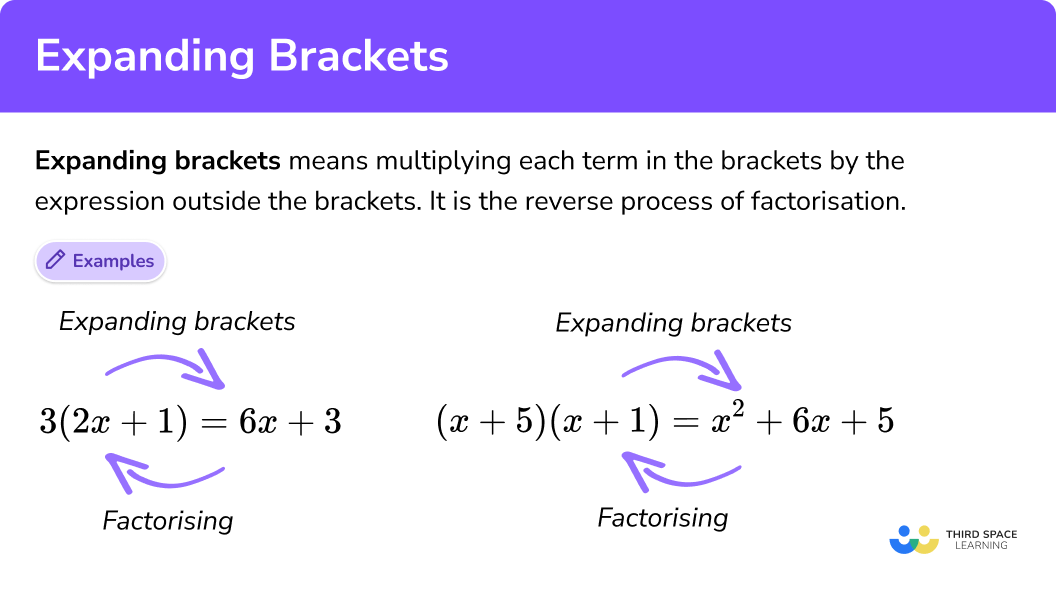
Related lessons on algebraic expressions
This lesson is part of our series of lessons to support revision on algebraic expressions. Related step by step guides include:
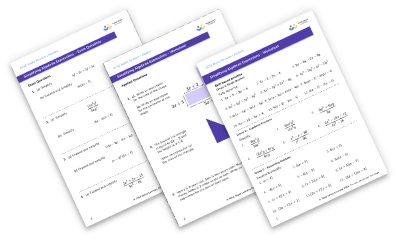
Expanding brackets worksheet

Download a free expanding brackets worksheet with 20+ reasoning and applied questions, answers and mark scheme to help your students prepare for GCSEs. Includes reasoning and applied questions.
DOWNLOAD FREE
Expanding brackets worksheet

Download a free expanding brackets worksheet with 20+ reasoning and applied questions, answers and mark scheme to help your students prepare for GCSEs. Includes reasoning and applied questions.
DOWNLOAD FREEMultiplying out brackets
‘Multiplying out brackets’ or ’multiply out’ is another term for expanding brackets. It means exactly the same thing. “Expand the brackets” is the same as “multiply out the brackets”, it just gives the additional clue that when we expand brackets, we are multiplying everything outside the brackets by everything inside the brackets.
Use of brackets
One use of brackets in maths in maths is to group items together, another is to give information about the order of operations.
E.g
Here is a rectangle.

Its perimeter is:
(x+8)+(x-3)+(x+8)+(x-3)Here the brackets are used to group the terms so that the expressions for the sides are clear.
The perimeter can also be written as:
2(x+8)+2(x-3)Here brackets are needed to preserve that the whole expressions for the sides are doubled to find the perimeter of a rectangle.
How to expand brackets
In order to expand brackets you need to multiply the terms outside the brackets (or parentheses) by the terms inside the brackets. There are three main ways to do this, each of which is explained below.
- Expanding single brackets
- Expanding double brackets
- Expanding triple brackets
How to expand brackets
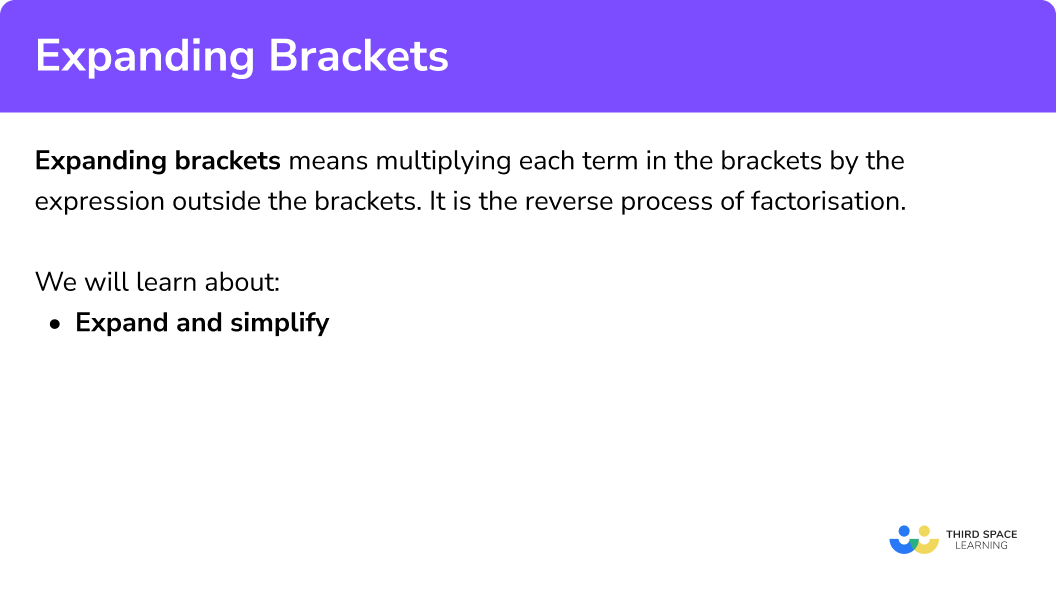
- Expanding single brackets
Expressions with two terms like
2. Expanding double brackets
Expressions with three terms like
Terms that are raised to the power of
3. Expanding triple brackets
A polynomial expression consists of two or more algebraic terms.
Expanding brackets with surds
There is a fourth, more complex situation in which you may need to use your expanding brackets knowledge but this is usually only seen on the higher level GCSE maths papers so is not part of this lesson.
In summary, in order to expand brackets involving surds we multiply every term outside the brackets by every term inside the brackets and follow the rules of surds.
For example if we expand
We will get
Step-by-step guide: Surds
1) Expanding single brackets
To expand a single bracket we multiply the term outside of the bracket by everything inside of the bracket.
How to expand single brackets
In order to expand single brackets:
- Multiply the term outside of the bracket by the first term inside the bracket.
- Multiply the term outside the bracket by the second term inside the bracket.
How to expand single brackets
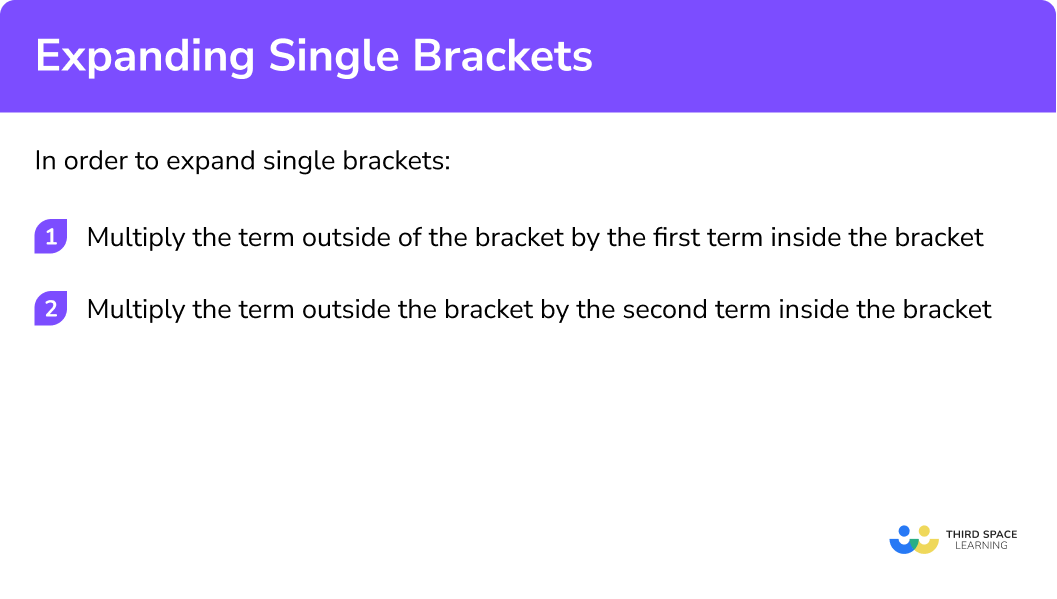
Expanding brackets examples (single brackets)
Example 1: two terms in the bracket
Expand:
2(x + 3)
| ✕ | x | + 3 |
| 2 | 2x |
- Multiply the term outside of the bracket
(2) by the first term inside the bracket(x) .
2Multiply the value outside the bracket
| ✕ | x | + 3 |
| 2 | 2x | + 6 |
The answer is positive so we need to write +
Example 2: two terms in the bracket and a negative term outside
Expand:
− 3(y − 4)
Multiply the term outside of the bracket (− 3) by the first term inside the bracket (y).
| ✕ | y | − 4 |
| − 3 | − 3y |
− ✕ + = − so the answer is negative.
Multiply the term outside the bracket (− 3)by the second term inside the bracket (− 4).
| ✕ | y | − 4 |
| − 3 | − 3y | + 12 |
− ✕ − = + so the answer is positive. We need to write
Example 3: two terms in the bracket and variables with coefficients greater than 1
Expand:
3x(4x − 2y)
Multiply the term outside of the bracket (3x) by the first term inside the bracket (4x).
| ✕ | 4x | − 2y |
| 3x | 12x2 |
Multiply the term outside the bracket (3x) by the second term inside the bracket (−2y).
| ✕ | 4x | − 2y |
| 3x | 12x2 | − 6xy |
− ✕ + = − so the answer is negative. We need to write
Example 4: three terms in the bracket and variables with coefficients greater than 1
Expand:
2x(3 − 5y + 6x2)
Multiply the value outside of the bracket (2x) by the first term inside the bracket (3).
| ✕ | 3 | − 5y | 6x2 |
| 2x | 6x |
Multiply the value outside the bracket (2x) by the second term inside the bracket (−5y).
| ✕ | 3 | − 5y | 6x2 |
| 2x | 6x | − 10xy |
− ✕ + = − so the answer is negative. We need to write −
Multiply the value outside the bracket (2x) by the third term inside the bracket (6x^{2}).
| ✕ | 3 | − 5y | 6x2 |
| 2x | 6x | − 10xy | + 12x3 |
The answer is positive so we need to write +
Practice expanding brackets questions (single brackets)
1. Expand: 6(y-2)




With a single bracket expansion, we must be sure to multiply each term inside the bracket by the number in front of the bracket.
2. Expand: -2(x+6)




With a single bracket expansion, we must be sure to multiply each term inside the bracket by the number in front of the bracket. Care must be taken when multiplication involves negative numbers.
3. Expand: y(2y-3)




With a single bracket expansion, we must be sure to multiply each term inside the bracket by the number in front of the bracket. Make sure to include the correct index numbers.
4. Expand: -5x(2x+4)




With a single bracket expansion, we must be sure to multiply each term inside the bracket by the number in front of the bracket. Make sure to include the correct index numbers. Care must be taken when multiplication involves negative numbers.
5. Expand: 4(8-3x+2y)




With a single bracket expansion, we must be sure to multiply each term inside the bracket by the number in front of the bracket.
6. Expand: 3y(2+7y-4x)




With a single bracket expansion, we must be sure to multiply each term inside the bracket by the number in front of the bracket. Make sure to include the correct index numbers.
2) Expanding double brackets
To expand double brackets we multiply every term in the first bracket, by every term in the second bracket.
How to expand double brackets
In order to expand double brackets follow these steps:
- Draw a grid and insert the terms of the first and second brackets.
- Fill in the grid by multiplying each of the terms together.
- Write out each of the terms and simplify the expression by collecting like terms.
How to expand double brackets
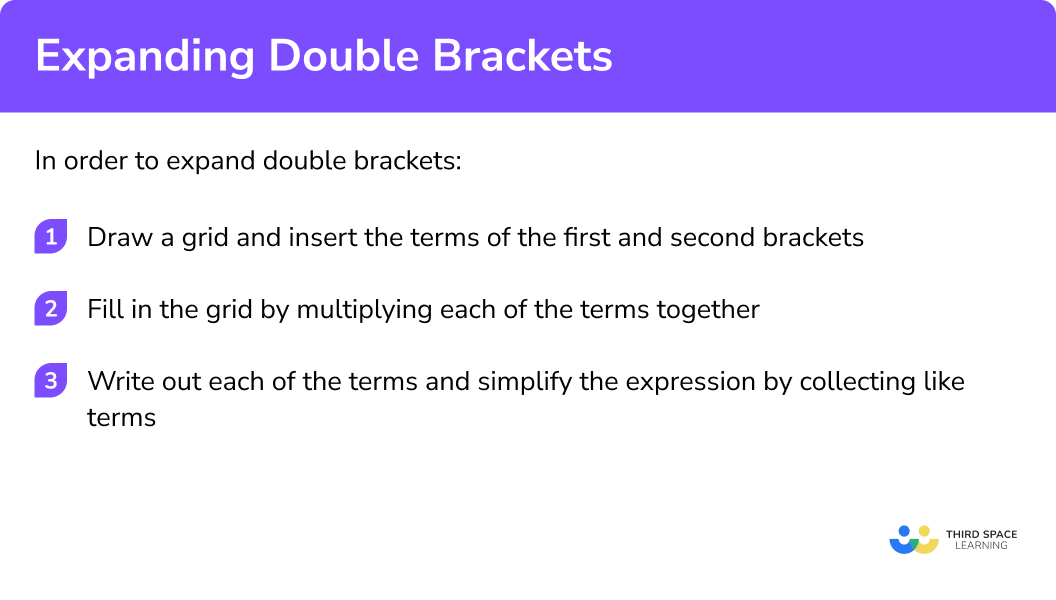
Expanding brackets examples (double brackets)
Example 1: variables have a coefficient of 1 and there is + in both brackets
Expand and simplify:
(x+2)(x+3)
- Draw a grid and insert the terms of the first and second brackets.
| ✕ | x | + 3 |
| x | ||
| + 2 |
2Fill in the grid by multiplying each of the terms together.
| ✕ | x | + 3 |
| x | x2 | + 3x |
| + 2 | + 2x | + 6 |
x ✕ x = x2 x ✕ 3 = 3x x ✕ 2 = 2x 2 ✕ 3 = 6
3Write out each of the terms and simplify the expression by collecting like terms.
x2 + 3x + 2x + 6 = x2 + 5x + 6
Example 2: variables have a coefficient of 1 and there is + in one bracket and – in the other
Expand and simplify:
(x + 5)(x − 1)
Draw a grid and insert the terms of the first and second brackets.
| ✕ | x | − 1 |
| x | ||
| + 5 |
Fill in the grid by multiplying each of the terms together.
| ✕ | x | − 1 |
| x | x2 | − x |
| + 5 | + 5x | − 5 |
x ✕ x = x2 x ✕ − 1 = − x
+ ✕ − = − so the answer is negative.
x ✕ 5 = 5x 5 ✕ − 1 = − 5
+ ✕ − = − so the answer is negative.
Write out each of the terms and simplify the expression by collecting like terms.
x2 − x + 5x − 5 x2 + 4x − 5
Example 3: variables have a coefficient greater than 1 and there is + in one bracket and – in the other
Expand and simplify:
(2x − 3)(x + 4)
Draw a grid and insert the terms of the first and second brackets.
| ✕ | x | + 4 |
| 2x | ||
| − 3 |
Fill in the grid by multiplying each of the terms together.
| ✕ | x | + 4 |
| 2x | 2x2 | + 8x |
| − 3 | − 3x | − 12 |
2x ✕ x = 2x2 2x ✕ 4 = 8x x ✕ − 3 = − 3x
+ ✕ − = − so the answer is negative.
4 ✕ − 3 = − 12
+ ✕ − = − so the answer is negative.
Write out each of the terms and simplify the expression by collecting like terms.
2x2 + 8x − 3x − 12 2x2 + 5x − 12
Example 4: squared brackets
Expand and simplify:
(3x − 4)2
Draw a grid and insert the terms of the first and second brackets.
(3x − 4)2 = (3x − 4)(3x − 4)
Remember: when we square something (raise it to the power of 2) we multiply it by itself.
| ✕ | 3x | − 4 |
| 3x | ||
| − 4 |
Fill in the grid by multiplying each of the terms together.
| ✕ | 3x | − 4 |
| 3x | 9x2 | − 12x |
| − 4 | − 12x | + 16 |
3x ✕ 3x = 9x2 3x ✕ − 4 = − 12x 3x ✕ − 4 = − 12x
+ ✕ − = − so the answer is negative.
− 4 ✕ − 4 = + 16
− ✕ − = + so the answer is positive.
Write out each of the terms and simplify the expression by collecting like terms.
9x2 − 12x − 12x + 16 9x2 − 24x + 16
Practice expanding brackets questions (double brackets)
1. Expand and simplify: (x+5)(x+6)




(x+5)(x+6)
Expanding the brackets gives
x^{2}+6x+5x+30
and then we can collect like terms
x^{2}+11x+30
2.Expand and simplify: (x-4)(x+2)




Expanding the brackets gives
x^{2}+2x-4x-8
and then we can collect like terms
x^{2}-2x-8
3.Expand and simplify: (2x+3)(x+4)




Expanding the brackets gives
2x^{2}+8x+3x+12
and then we can collect like terms
2x^{2}+11x+12
4. Expand and simplify: (3x-2)(x+1)




Expanding the brackets gives
3x^{2}+3x-2x-2
and then we can collect like terms
3x^{2}+x-2
5. Expand and simplify: (x-4)^{2}




means the same as
(x-4)(x-4)
so we can expand as usual
x^{2}-4x-4x+16
and then collect like terms
x^{2}-8x+16
6.Expand and simplify: (2x+5)^{2}




means the same as
(2x+5)(2x+5)
so we can expand as usual
4x^{2}+10x+10x+25
and then collect like terms
4x^{2}+20x+25
3) Expanding triple brackets
To expand triple brackets we first multiply the first two brackets together. We then multiply every term in this new expression by every term in the third bracket.
How to expand triple brackets
In order to expand triple brackets:
- Draw a grid, insert the terms of the first and second brackets, then fill it in by multiplying each of the terms together.
- Write out each of the terms and simplify the expression by collecting like terms.
- Draw a grid, insert the terms from this new expression and the third bracket, then fill it in by multiplying each of the terms together.
- Write out each of the terms and simplify the expression by collecting like terms.
How to expand triple brackets
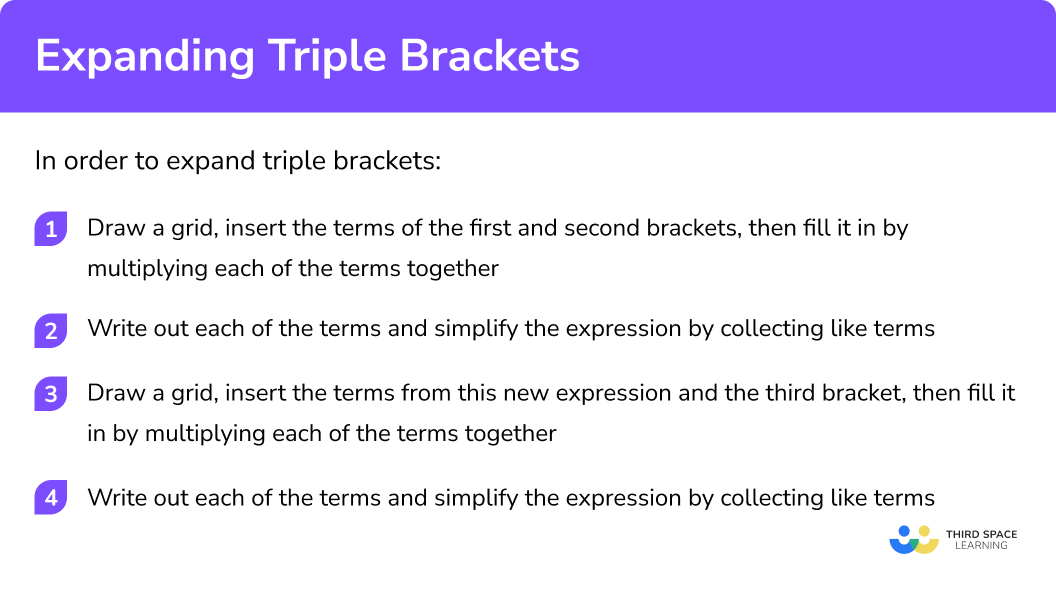
Expanding brackets examples (triple brackets)
Example 1: multiply three brackets
Expand and simplify:
(x + 1)(x + 2)(x + 3)
- Draw a grid, insert the terms of the first and second brackets, then fill it in by multiplying each of the terms together.
| ✕ | x | + 2 |
| x | x2 | + 2x |
| + 1 | + x | + 2 |
x ✕ x = x2 x ✕ 2 = 2x x ✕ 1 = x 1 ✕ 2 = 2
2Write out each of the terms and simplify the expression by collecting like terms.
x2 + 2x + x + 2 x2 + 3x + 2
3Draw a grid, insert the terms from this new expression and the third bracket, then fill it in by multiplying each of the terms together.
| ✕ | x2 | + 3x | + 2 |
| x | x3 | + 3x2 | + 2x |
| + 3 | + 3x2 | + 9x | + 6 |
x ✕ x2 = x3 x ✕ 3x = 3x2 x ✕ 6 = 6x 3 ✕ x2 = 3x2 3 ✕ 3x = 9x 3 ✕ 6 = 18
4Write out each of the terms and simplify the expression by collecting like terms.
x3 + 3x2 + 3x2 + 9x + 2x + 6 x3 + 6x2 + 11x + 6
Example 2: squared brackets multiplied by a third bracket
Expand and simplify:
(x + 3)2(x − 1)
Draw a grid, insert the terms of the first and second brackets, then fill it in by multiplying each of the terms together.
| ✕ | x | + 3x |
| x | x2 | + 3x |
| + 3 | + 3x | + 9 |
(x + 3)2 = (x + 3)(x + 3) x ✕ x = x2 x ✕ 3 = 3x x ✕ 3 = 3x 3 ✕ 3 = 9
Write out each of the terms and simplify the expression by collecting like terms.
x2 + 3x + 3x + 9 x2 + 6x + 9
Draw a grid, insert the terms from this new expression and the third bracket, then fill it in by multiplying each of the terms together.
| ✕ | x2 | + 6x | + 9 |
| x | x3 | + 6x2 | + 9x |
| − 1 | − x2 | − 6x | − 9 |
x ✕ x2 = x3 x ✕ 6x = 6x2 x ✕ 9 = 9x − 1 ✕ x2 = − x2 − 1 ✕ 6x = − 6x − 1 ✕ 9= − 9
Write out each of the terms and simplify the expression by collecting like terms.
x3 + 6x2 − x2 + 9x − 6x − 9 x3 + 5x2 + 3x − 9
Practice expanding brackets questions (triple brackets)
1. Expand and simplify: (x+2)(x+3)(x+4)




Expanding the first two brackets gives
(x^{2}+3x+2x+6)(x+4)
or
(x^{2}+5x+6)(x+4)
and then expanding again
x^{3}+4x^{2}+5x^{2}+20x+6x+24
Collect like terms
x^{3}+9x^{2}+26x+24
2. Expand and simplify: (x+3)(x-2)^2




can be written as
(x+3)(x-2)(x-2)
Expanding the two identical brackets first gives
(x+3)(x^{2}-2x-2x+4) (x+3)(x^{2}-4x+4)
and expanding again
x^{3}-4x^{2}+4x+3x^{2}-12x+12
then collect like terms
x^{3}-x^{2}-8x+123.Expand and simplify: (2x+1)^3




(2x+1)^{3}
can be written as
(2x+1)(2x+1)(2x+1)
Expanding two of the brackets gives
(2x+1)(4x^{2}+2x+2x+1)
(2x+1)(4x^{2}+4x+1)
and expanding again
8x^{3}+8x^{2}+2x+4x^{2}+4x+1
then collect like terms
8x^{3}+12x^{2}+6x+1
Common misconceptions
- We must multiply the value outside the brackets by every term inside the brackets.
2(6x2 − 3x) = 12x2 − 3x ✖
Here we have multiplied the value outside of the brackets by the first term inside of the bracket, but not the second term.
The correct answer is
We need to multiply all the terms inside the bracket.
- For two numbers to multiply to give a + their signs must be the same.
- For two numbers to multiply to give a − their signs must be different.
− 4(3y − 5) = − 12y − 20 ✖
Here we have not used − ✕ − = +
− 4 ✕ − 5 = + 20
The correct answer is
- When we square something, we multiply it by itself.
32 = 3 ✕ 3 x2 = x ✕ x (5y)2 = 5y ✕ 5y
- When we square a bracket, we multiply it by the entire bracket.
(x + 3)2 = (x + 3)(x + 3) ✔ NOT x2 + 9 ✖
Expanding brackets GCSE questions
Learning checklist
You have now learned how to:
-
Multiply a single term over a bracket
-
Expand products of 2 or more binomials
The next lessons are
Still stuck?
Prepare your KS4 students for maths GCSEs success with Third Space Learning. Weekly online one to one GCSE maths revision lessons delivered by expert maths tutors.

Find out more about our GCSE maths tuition programme.